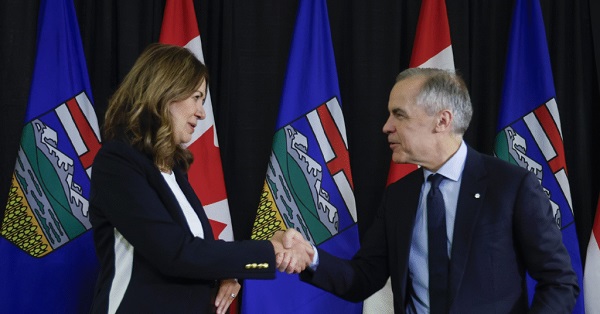Business
The “GST Holiday”… A Smokescreen For Scandal

A GST holiday sounded like it might be a good thing, but it turned out to be a gimmick to distract us from more serious issues, writes Marco Navarro-Genie. Courtesy Ivanoh Demers/Radio-Canada
One more racket from a government that rules by racket
The Prime Minister’s proposed GST holiday and $250 rebate scheme, initially estimated at $6.2 billion, is yet another calculated ploy to distract Canadians from the ethical failures of his government. Though the rebate portion was abandoned in Parliament, the GST holiday remains a superficial gesture in a government-induced affordability crisis.
This tactic highlights the government’s willingness to appear generous (with our money) while burdening taxpayers with increased debt to mask corruption and maintain power.
At the heart of this deflection lies the Sustainable Development Technology Canada (SDTC) program, dubbed by critics as the “Green Slush Fund.”
The Auditor General recently revealed shocking improprieties within the program. The findings include that the federal ethics office reported at least 90 violations of ethics rules and nearly $400 million handed out to companies linked to SDTC board members. This gross misuse of public funds undermines the program’s goals of fostering green innovation, instead solidifying public skepticism about Ottawa’s ethical compass.
Efforts to hold the government accountable for its mismanagement have faced significant obstruction. Parliament has requested unredacted documents related to the scandal but has been met with resistance from the government. Trudeau’s administration has provided vague justifications for its refusal to comply, citing reasons such as protecting commercial confidentiality and national security.
The Speaker of the House, a Liberal MP, ruled that Parliament has the constitutional right to demand these documents. He ordered the government to release them unredacted. However, weeks have now passed, and the government continues its obstructionist tactics. Parliament has been stalled for weeks, effectively freezing legislative proceedings.
Under parliamentary rules, the House can halt all proceedings until the government complies with the Speaker’s ruling. However, the Speaker lacks direct enforcement power, leaving the opposition parties to hold the line. Last week, the government attempted to submit documents but presented them in a heavily redacted form, further eroding trust.
The standoff highlights the lengths the federal government will go to avoid transparency. By refusing to release the documents, the Liberals undermine Parliament’s authority and delay critical legislative work to protect themselves from scrutiny.
The two-month GST holiday passed with NDP support, removes the GST/HST from:
- Prepared foods: Items like pre-made meals and restaurant dining.
- Children’s essentials: Clothing, footwear, and diapers.
- Select gift items: Categories remain vaguely defined.
However, basic groceries are already GST-exempt. According to food policy expert Sylvain Charlebois, the average Canadian household will save only a few dollars. This gesture is hardly a windfall in the context of surging inflation and housing costs — driven mainly by the government’s policies.
The fundamental aim of the GST holiday is not economic relief but political manipulation. By framing the Conservatives’ refusal to pass the broader $6.2 billion package as heartless, the government seeks to paint the Official Opposition as the Grinch who stole Christmas.
Liberal MPs have already taken to social media to attack the Conservatives for “denying Canadians a tax break.”
The government seems silent about the fact that the Bloc Quebecois also voted against the tax gimmick. Meanwhile, the NDP has shown a willingness to facilitate this naked vote-buying bid, further eroding its credibility as an opposition party.
The Conservatives have remained steadfast, demanding full transparency on the SDTC scandal before regular proceedings in the House can resume. This stance, however, has allowed the Liberals to weaponize affordability relief as a wedge issue.
The GST holiday’s costs, like most federal spending under this government, will disproportionately fall on Alberta, Saskatchewan, and British Columbia. These three provinces already bear the brunt of federal revenue extraction through resource wealth, only to see their contributions funnelled into vote-rich areas of central Canada to prop up an increasingly unpopular government. The move further stokes resentment in the West, damaging national unity.
How this standoff will resolve is anyone’s guess. The government appears content to drag its feet, betting that public fatigue will weaken opposition resolve. Yet it remains clear that Liberals are willing to misspend billions in borrowed money to hide how they’ve misused hundreds of millions on partisan rewards and cronies. This cynical strategy prioritizes the political survival of their arrangement with the NDP over fiscal responsibility and democratic accountability.
For democracy to function, Parliament must assert its supremacy, hold this minority government to account, and ensure transparency in the face of systemic corruption and mismanagement. The NDP’s collaboration with the offenders may make it impossible, however. Allowing the government to defy Parliament and the Speaker’s ruling sets a dangerous precedent, weakening the foundations of Canadian democracy.
Marco Navarro-Genie is VP Policy and Research at the Frontier Centre for Public Policy. He is co-author, with Barry Cooper, of COVID-19: The Politics of a Pandemic Moral Panic (2020).
Business
Warning Canada: China’s Economic Miracle Was Built on Mass Displacement

If you think the CCP will treat foreigners better than its own people, when it extends its power over you, please think again: Dimon Liu’s warning to Canadian Parliament.
Editor’s Note: The Bureau is publishing the following testimony to Canada’s House of Commons committee on International Human Rights from Dimon Liu, a China-born, Washington, D.C.-based democracy advocate who testified in Parliament on December 8, 2025, about the human cost of China’s economic rise. Submitted to The Bureau as an op-ed, Liu’s testimony argues that the Canadian government should tighten scrutiny of high-risk trade and investment, and ensure Canada’s foreign policy does not inadvertently reward coercion. Liu also warns that the Chinese Communist Party could gain leverage over Canadians and treat them as it has done to its own subjugated population—an implied message to Prime Minister Mark Carney, who has pledged to engage China as a strategic partner without making that position clear to Canadians during his election campaign.
OTTAWA — It is an honor to speak before you at the Canadian Parliament.
My testimony will attempt to explain why China’s economic success is built on the backs of the largest number of displaced persons in human history.
It is estimated that these displaced individuals range between 300 to 400 million — it is equivalent to the total population of the United States being uprooted and forced to relocate. These displaced persons are invisible to the world, their sufferings unnoticed, their plights ignored.
In 1978, when economic reform began, China’s GDP was $150 billion USD.
In 2000, when China joined the WTO, it was approximately $1.2 trillion USD.
China’s current GDP is approximately $18 trillion USD.
In 2000 China’s manufacturing output was smaller than Italy’s.
Today it’s larger than America, Europe, Japan, and South Korea combined.
If you have ever wondered how China managed to grow so fast in such a short time, Charles Li, former CEO of the Hong Kong Stock Exchange, has the answers for you.
He listed 4 reasons: 1) cheapest land, 2) cheapest labor, 3) cheapest capital, and 4) disregard of environmental costs.
“The cheapest land” because the CCP government took the land from the farmers at little to no compensation.
“The cheapest labor,” because these farmers, without land to farm, were forced to find work in urban areas at very low wages.
The communist household registration system (hukou 戶口) ties them perpetually to the rural areas. This means they are not legal residents, and cannot receive social benefits that legal urban residents are entitled. They could be evicted at any time.
One well known incident of eviction occurred in November 2017. Cai Qi, now the second most powerful man in China after Xi Jinping, was a municipal official in Beijing. He evicted tens of thousands into Beijing’s harsh winter, with only days, or just moments of notice. Cai Qi made famous a term, “low-end population” (低端人口), and exposed CCP’s contempt of rural migrants it treats as second class citizens.
These displaced migrant workers have one tradition they hold dear — it is to reunite with their families during the Chinese Lunar New Year holiday, making this seasonal migration of 100 to 150 million people a spectacular event. In China’s economic winter of 2025 with waves of bankruptcies and factory closures, the tide of unemployed migrant workers returning home to where there is also no work, and no land to farm, has become a worrisome event.
Historically in the last 2,000 years, social instability has caused the collapse of many ruling regimes in China.
“The cheapest capital” is acquired through predatory banking practices, and through the stock markets, first to rake in the savings of the Chinese people; and later international investments by listing opaque, and state owned enterprises in leading stock markets around the world.
“A disregard of environmental costs” is a hallmark of China’s industrialization. The land is poisoned, so is the water; and China produces one-third of all global greenhouse gases.
Chinese Communist officials often laud their system as superior. The essayist Qin Hui has written that the Chinese communist government enjoys a human rights abuse advantage. This is true. By abusing its own people so brutally, the CCP regime has created an image of success, which will prove to be a mirage.
If you think the CCP will treat foreigners better than its own people, when it extends its power over you, please think again.
The Bureau is a reader-supported publication.
To receive new posts and support my work, consider becoming a free or paid subscriber.
Business
Judge Declares Mistrial in Landmark New York PRC Foreign-Agent Case

U.S. District Judge Brian Cogan declared a mistrial Monday afternoon in the high-profile foreign-agent and corruption case against former New York state official Linda Sun and her husband Chris Hu, after jurors reported they were hopelessly deadlocked on all 19 counts.
After restarting deliberations Monday morning with an alternate juror, the panel sent a note to Judge Cogan stating:
“Your honor, after extensive deliberations and redeliberations the jury remains unable to reach a unanimous verdict. The jurors’ positions are firmly held.”
Cogan brought the jury into court and asked the foreman whether they had reached agreement on any counts. They replied that they were deadlocked on every one. The judge then declared a mistrial.
Assistant U.S. Attorney Alexander Solomon immediately told the court that the government intends to retry the case “as soon as possible.” A status conference is scheduled for January 26, 2026, to determine next steps.
Jury selection began November 10, 2025, and the government called 41 witnesses to the stand, compared with eight for the defense and one rebuttal witness for the prosecution. Deliberations began on December 12, and by this afternoon the jurors had sent three notes to the court — each indicating deadlock.
As The Bureau reported in its exclusive analysis Friday, the panel’s fracture had become visible as jurors headed into a second week of deliberations in a landmark foreign-agent and corruption trial that reached into two governors’ offices — a case asking a jury of New Yorkers to decide whether Sun secretly served Beijing’s interests while she and Hu built a small business and luxury-property empire during the pandemic, cashing in on emergency procurement as other Americans were locked down.
Prosecutors urged jurors to accept their account of a dense web of family and Chinese-community financial transactions through which Sun and Hu allegedly secured many millions of dollars in business deals tied to “United Front” proxies aligned with Beijing. The defense, by contrast, argued that Sun and Hu were simply successful through legitimate, culturally familiar transactions, not any covert scheme directed by a foreign state.
Sun and Hu face 19 charges in total, including allegations that Sun acted as an unregistered foreign agent for the People’s Republic of China; visa-fraud and alien-smuggling counts tied to a 2019 Henan provincial delegation; a multimillion-dollar pandemic PPE kickback scheme; bank-fraud and identity-misuse allegations; and multiple money-laundering and tax-evasion counts.
Prosecutors have argued that the clearest money trail ran through New York’s COVID procurement scramble and a pair of Jiangsu-linked emails. In closing, Solomon told jurors that Sun’s “reward” for steering contracts was “millions of dollars in kickbacks or bribes,” contending the money was routed through accounts opened in Sun’s mother’s name and via friends and relatives.
The government has tied those claims to a broader narrative — laid out in Solomon’s summation and dissected in The Bureau’s reporting — that Sun functioned as a “trusted insider” who repurposed state access and letterhead to advance Beijing’s priorities, including by allegedly forging Governor Kathy Hochul’s signature on invitation letters used for Chinese provincial delegations, while keeping those relationships hidden from colleagues. The defense, in turn, urged jurors to reject the government’s picture of clandestine agency and argued prosecutors had overreached by treating ordinary diaspora networking, trade promotion, and pandemic procurement as criminal conduct — insisting none of the evidence proved the “direction or control” element central to the Foreign Agents Registration Act.
Whether a future jury will see the same evidence as corruption and covert foreign agency or as culturally familiar commerce and politics — will now be tested again, on a new timetable, in a courtroom that has already shown just how difficult this record is to unanimously interpret.
The Bureau is a reader-supported publication.
To receive new posts and support my work, consider becoming a free or paid subscriber.
-

 International2 days ago
International2 days agoAustralian PM booed at Bondi vigil as crowd screams “shame!”
-

 Uncategorized2 days ago
Uncategorized2 days agoMortgaging Canada’s energy future — the hidden costs of the Carney-Smith pipeline deal
-

 Alberta1 day ago
Alberta1 day agoAlberta Next Panel calls to reform how Canada works
-

 Automotive1 day ago
Automotive1 day agoCanada’s EV gamble is starting to backfire
-

 Digital ID20 hours ago
Digital ID20 hours agoCanadian government launches trial version of digital ID for certain licenses, permits
-

 Agriculture1 day ago
Agriculture1 day agoEnd Supply Management—For the Sake of Canadian Consumers
-

 Business19 hours ago
Business19 hours agoThe “Disruptor-in-Chief” places Canada in the crosshairs
-

 International3 hours ago
International3 hours agoGeorgia county admits illegally certifying 315k ballots in 2020 presidential election






